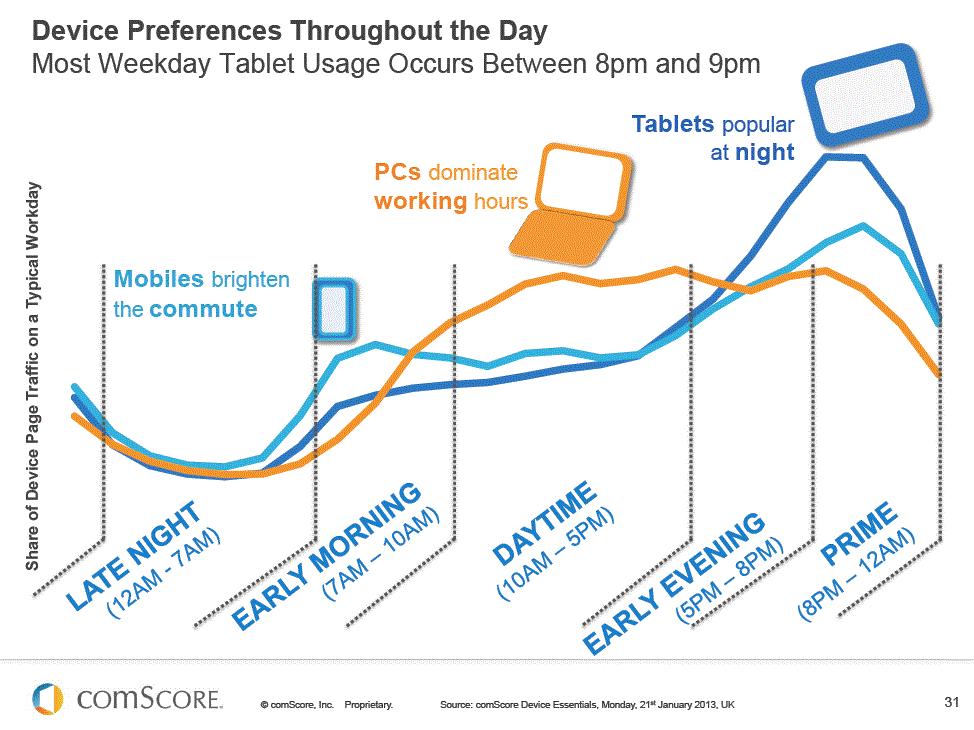This blog is about mobile devices. The smartphone in your pocket or bag. The tablet you read on the train or scan whilst the telly is on. They’re everywhere, but very few businesses are doing anything remotely ‘smart’ with them at all.
At the start of the year I switched my older smartphone for a ‘latest generation’ device. It’s still a phone, a browser, email handler and so on, a bit lighter, a bit neater than the old one – but that’s not my point. It’s actually a gateway for businesses to really start interacting with me, but either I’m not a target for their products, or they’re just not doing it yet.
Mobile use and smartphone take up is rapid. Latest stats from the really useful (and FREE) data by Google called Our Mobile Planet show 51% of the UK population own one (up from 31% a year earlier) each with an average of 23 Apps installed. At home we’re two screening and with 4G allowing faster access and making it possible to have connections almost as quick as home broadband, the technology is waiting to be used.
Research from Comscore shows the patterns of device usage through the day and you can see that mobile is right there front and centre of everything we do.
The key thing from this chart is that when you’re building your business strategy, you must recognise the mobile opportunity. Think about how your business can add value to people as they use smartphones or tablets. It’s not just about selling stuff, it’s about providing a service to make them feel more than just an eCommerce transaction and actually become part of their lives.
The mobile phone companies – EE, O2, Vodafone – have formed something called Weve to try and help. They claim
‘a new focal point for a whole new set of experiences and ideas across the mobile spectrum, everywhere from mobile marketing and advertising to payments and transactions, loyalty programs and coupons’
Which I read as ‘let’s try and get businesses to use this mobile stuff so that we can sell airtime’ – and that’s just fine. Because we need to start using the tools we have to hand and business needs some catalyst to get things going. See Neville Hobson’s blog about Weve for more.
So, what can you do about it today, in your business?
Don’t fall into the trap of waiting for someone else to find the solution, or they’ll eat your lunch. Seize the moment and spend a little time looking, listening and reflecting. With some creative thinking you can identify the opportunities in your business (whatever your business does) to develop closer and more valuable links to customers through mobile technology.
Cost is not the barrier, because technology is relatively cheap. The challenge is to see your products through your customers eyes, on their mobile device.
Another practical step is to adopt a responsive design approach to all of your assets, and mobile should be at the heart of this.
Right now there is an open goal, and you can score a lot of goals (and quickly) by taking some simple steps to focus your activity.
About Al Clarke – I am a marketing and communications specialist who has worked in the motor industry at board level since 1997. I have held senior positions in global brands such as Ferrari and the BBC including a decade working as a journalist.I am a member of the Institute of Directors, the Public Relations Consultants Association, an expert member of the digital community Smart Insights and Life President of the Motor Industry Public Affairs Association.I speak regularly in the field of marketing communications to businesses and the media with particular reference to digital media. Find me on Twitter @alclarkeltd and LinkedIn.


Comments 2
Good Comscore stats on multi-device consumption, they highlight the importance of personalisation for which Data and Content strategy are two key factors. I see it as a cascade effect; the data, or should I say the right data insights, will aid informed decisions on customer behaviour and engagement; what information are customers consuming across different devices at different times and how are the current business systems set up to manage this. To quote Adam Audette and George Michie of Rimm-Kauffman Group on mobile websites “Responsive design helps, but smartphone users have fundamentally different needs and only a site designed to meet those unique needs will produce the best outcome for the user and for the business.” There are generally 3 considered approaches when it comes to mobile; responsive web design, dynamic serving and mobile URLs. What’s good for your business may be different to someone else, if for example the information architecture of your website has issues, then responsive web design may not be ideal until that is resolved. Don’t be a ‘responsive band wagoneer’ develop a solution that best fits the customer and business need which may be a hybrid of responsive web design and mobile-only pages.
Author
Updated information from @jangles (Neville Hobson) in his blog today 13 May 2014
http://www.nevillehobson.com/2014/05/13/how-up-to-speed-are-you-about-mobile/